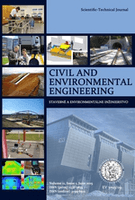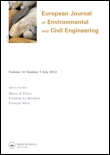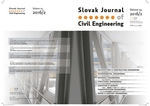
Civil and Environmental Engineering
Scope & Guideline
Elevating research to shape the future of engineering.
Introduction
Aims and Scopes
- Sustainable Infrastructure Development:
Research that emphasizes the design, construction, and maintenance of infrastructure systems that minimize environmental impacts and promote sustainability. - Innovative Construction Materials:
Studies exploring new materials, including recycled and eco-friendly options, that enhance the performance and sustainability of construction projects. - Structural Engineering and Analysis:
Investigations into the behavior, design, and optimization of various structural elements under different loading conditions, including earthquake and wind loads. - Environmental Impact Assessment:
Research focusing on the evaluation of the environmental effects of construction projects and urban development, including methodologies for assessing air, water, and soil quality. - Geotechnical Engineering:
Exploration of soil behavior, foundation design, and slope stability, often incorporating advanced modeling techniques and materials. - Urban and Regional Planning:
Studies related to urban development, infrastructure planning, and the integration of green technologies to improve urban resilience and livability. - Water Resource Management:
Research addressing the challenges of water supply, wastewater treatment, and stormwater management, emphasizing innovative solutions and sustainability. - Transportation Engineering:
Examination of transportation systems, traffic management, and the impacts of infrastructure on urban mobility and environmental sustainability.
Trending and Emerging
- Green Building Technologies:
There is a growing emphasis on research related to green building practices, including energy efficiency, sustainable materials, and innovative design techniques. - Resilience and Disaster Mitigation:
An increasing number of studies focus on enhancing the resilience of structures and communities against natural disasters, including earthquakes and flooding. - Advanced Materials and Recycling:
Emerging research on the use of recycled materials in construction, such as plastic waste and industrial by-products, is gaining traction as part of sustainability initiatives. - Smart Infrastructure and Technology Integration:
The integration of smart technologies in civil engineering, including IoT and data analytics for infrastructure monitoring and management, is becoming a prominent theme. - Climate Change Adaptation Strategies:
Research on how civil engineering practices can adapt to climate change impacts, focusing on sustainable practices that mitigate risks associated with extreme weather events.
Declining or Waning
- Traditional Pavement Engineering:
Papers solely focused on conventional pavement materials and designs are becoming less frequent, as there is a growing interest in sustainable and innovative pavement solutions. - Historical Structures and Preservation:
Research related to the restoration and preservation of historical structures is declining, possibly due to a shift towards more contemporary engineering challenges and sustainability issues. - Basic Soil Mechanics:
Fundamental studies in soil mechanics, while still important, are being overshadowed by applied research that focuses on innovative solutions and advanced materials. - Conventional Water Treatment Processes:
Studies on traditional water treatment methods are declining, as there is a trend towards exploring more sustainable and advanced technologies for water purification. - Static Structural Analysis:
Research focusing exclusively on static analysis methods is waning, with a noticeable shift towards dynamic analysis and performance-based design approaches.
Similar Journals

Electronic Journal of the Faculty of Civil Engineering Osijek-e-GFOS
Exploring New Frontiers in Civil Engineering ExcellenceWelcome to the Electronic Journal of the Faculty of Civil Engineering Osijek-e-GFOS, a prominent platform dedicated to the dissemination of innovative research in the field of civil engineering. Published by the University of Osijek, this Open Access journal has been accessible to the global academic community since 2010, facilitating the sharing of knowledge and advancements without financial barriers. With an E-ISSN of 1847-8948, the journal aims to cover a broad scope of civil engineering disciplines, including structural engineering, geotechnics, environmental engineering, and construction management, among others. It serves as a crucial resource for researchers, professionals, and students, providing them with insightful articles and studies that contribute to the development of best practices in the field. By promoting open collaboration and knowledge sharing, the Electronic Journal of the Faculty of Civil Engineering Osijek-e-GFOS stands as a testament to the commitment of the University of Osijek to enhance the field of civil engineering through impactful research and educational outreach.

European Journal of Environmental and Civil Engineering
Exploring Interdisciplinary Approaches to Environmental ChallengesThe European Journal of Environmental and Civil Engineering, published by Taylor & Francis Ltd, is a prestigious peer-reviewed journal that serves as a vital platform for advancing knowledge in the fields of Civil and Structural Engineering as well as Environmental Engineering. With an impressive impact factor and categorized in the Q2 quartile for both engineering fields, this journal occupies a significant position in the scholarly community. Its focused scope encompasses innovative research, case studies, and practical applications that address contemporary environmental and infrastructural challenges. Researchers, professionals, and students alike benefit from the journal's commitment to high-quality discourse, as evidenced by its Scopus rankings, which place it in the top 30% in Civil and Structural Engineering and the top 40% in Environmental Engineering. Through the publication of cutting-edge studies and a commitment to fostering interdisciplinary dialogue, the European Journal of Environmental and Civil Engineering remains an essential resource for those dedicated to improving our built environment and safeguarding our natural resources.

Turkish Journal of Civil Engineering
Fostering Collaboration for a Sustainable FutureWelcome to the Turkish Journal of Civil Engineering, a pioneering publication under the auspices of the TURKISH CHAMBER OF CIVIL ENGINEERS, dedicated to advancing the field of civil engineering and construction. With a focus on cutting-edge research and innovative practices, this journal seeks to provide a platform for scholars, professionals, and students to share their findings and insights within the sphere of civil and structural engineering. The journal is committed to open access, ensuring that research is readily available to a global audience. As it embarks on its journey from 2023 to 2024, it aims to enhance its reputation as a vital resource within the academic community, currently ranking in the 40th percentile for Building and Construction Engineering and 32nd for Civil and Structural Engineering in Scopus. We encourage contributions that push the boundaries of engineering knowledge, fostering collaboration and progress in this essential field.

Transportation Infrastructure Geotechnology
Empowering Engineers with Cutting-Edge Geotechnical Insights.Transportation Infrastructure Geotechnology, an esteemed journal published by SpringerNature, serves as a vital platform in the fields of Civil and Structural Engineering, Environmental Engineering, Geotechnical Engineering, and Transportation. Established in 2014 and spanning a decade of significant scientific discourse, this journal has gained recognition for its robust contribution to the understanding of the interplay between geotechnical processes and transportation infrastructure. With an impactful Q2 ranking in multiple categories—including Civil and Structural Engineering and Environmental Engineering—it emphasizes innovative research and practical applications globally. Researchers and professionals can explore critical topics that influence infrastructure sustainability, safety, and efficiency. Although it operates under a subscription model, its affiliation with SpringerNature ensures rigorous peer-review and high-quality publications, making it an indispensable resource for academics and industry experts alike.

Infrastructures
Driving Progress in Civil and Structural EngineeringInfrastructures is a distinguished open-access journal, published by MDPI since 2016, dedicated to advancing the fields of engineering and construction through interdisciplinary research and critical insights. Based in Switzerland, it serves a global community of scholars and professionals, providing a platform for innovative studies that drive progress in Building and Construction, Civil and Structural Engineering, Computer Science Applications, Geotechnical Engineering and Engineering Geology, and various aspects of Materials Science. With an impressive impact factor and a positioning in the Q2 category across multiple engineering fields, the journal's robust ranking reflects its commitment to high-quality research, with notable Scopus rankings showcasing its significant contribution to academic discourse. Infrastructures not only facilitates open access to essential knowledge but also aims to bridge the gap between theory and practical application, making it an invaluable resource for researchers, industry professionals, and students alike.

Jordan Journal of Civil Engineering
Transforming Ideas into Engineering SolutionsThe Jordan Journal of Civil Engineering, ISSN 1993-0461 and E-ISSN 2225-157X, serves as a pivotal platform for research dissemination in the field of civil engineering. Published by Jordan University of Science & Technology, this journal has established itself as a vital resource since its inception in 2007 and continues to impact the academic community with its wide-ranging scope covering innovative practices and cutting-edge research in civil and structural engineering. Holding a respectable Q3 ranking in the 2023 category, with Scopus positioning it at rank #235 out of 379, the journal reflects growing recognition within its discipline. Although currently not an open-access publication, it provides essential insights that can benefit researchers, industry professionals, and students seeking to contribute to advancements in civil engineering through rigorous scholarly articles and studies up to 2024. Its commitment to high academic standards enhances the relevance and importance of its contributions to both local and global engineering practices.

Advances in Civil and Architectural Engineering
Unlocking the Potential of Interdisciplinary EngineeringAdvances in Civil and Architectural Engineering is a cutting-edge scholarly journal dedicated to the dissemination of pioneering research in the realm of civil engineering and architecture. Published by the esteemed Josip Juraj Strossmayer University of Osijek, Faculty of Civil Engineering and Architecture, this journal operates under an Open Access model since 2022, allowing for unrestricted access to its rich repository of articles. The journal aims to bridge the gap between academia and industry by providing a platform for innovative studies, technical advancements, and best practices that contribute to the evolution of sustainable construction and architectural design. With its focus on interdisciplinary approaches and contemporary challenges in the field, Advances in Civil and Architectural Engineering serves as an invaluable resource for researchers, professionals, and students seeking to enhance their understanding and impact in this vital area of engineering. The journal's ISSN is 2975-3848, and it is committed to fostering the advancement of knowledge and collaboration within the global engineering community.

International Journal of Civil Engineering
Elevating Standards in Civil and Structural EngineeringThe International Journal of Civil Engineering, published by Springer International Publishing AG, is a premier platform dedicated to advancing the field of civil engineering. With a notable impact factor and a strong reputation reflected in its Q2 quartile rankings in both Civil and Structural Engineering as well as Geotechnical Engineering and Engineering Geology, this journal facilitates the dissemination of high-quality research from 2009 through 2024. Researchers and professionals can access cutting-edge studies and innovative practices that address contemporary challenges in civil engineering, such as sustainable infrastructure development, environmental impacts, and advanced material technologies. Situated in Switzerland, the International Journal of Civil Engineering emphasizes the critical interplay between theory and application, making it an essential resource for students, academics, and industry leaders seeking to stay at the forefront of their disciplines.

Teknik Dergi
Building Knowledge, Shaping FuturesTeknik Dergi is a key academic journal published by the Turkish Chamber of Civil Engineers, focusing on the critical fields of Building and Construction as well as Civil and Structural Engineering. Established in Turkey, this journal serves as a vital platform for researchers, practitioners, and students to disseminate innovative findings and advancements within these disciplines. Although its coverage in databases like Scopus has been discontinued since 2022, Teknik Dergi remains a respected resource for its historical contributions, with a record of publication spanning from 1990 to 1998 and then from 2002 to 2022. The journal currently holds a Q4 categorization in both its primary fields, ranking within the 30th and 25th percentiles respectively. Authors and readers can access articles exploring practical applications and theoretical foundations, making it a valuable asset for those engaged in the rapidly evolving landscape of civil engineering. Open Access options are also available, allowing for broader dissemination and engagement with its published work.

Slovak Journal of Civil Engineering
Innovating infrastructure: Bridging theory and practice.Welcome to the Slovak Journal of Civil Engineering, a premier open-access publication dedicated to advancing the field of civil engineering. Published by SCIENDO, this journal has been providing a platform for the dissemination of groundbreaking research since 2010, ensuring that all articles are freely accessible to a global audience. With a commitment to promoting innovation and excellence within civil engineering, the journal covers a wide range of topics, including structural engineering, transportation systems, geotechnics, and environmental engineering. The Slovak Journal of Civil Engineering is designed to engage a diverse community of researchers, professionals, and students, fostering collaboration and knowledge-sharing to address contemporary challenges in the field. With its open-access model, the journal not only enhances visibility for authors but also ensures that the latest findings and methodologies reach practitioners and academics alike, making it an essential resource for anyone interested in civil engineering advancements. Stay connected with the evolving landscape of civil engineering through this influential publication.